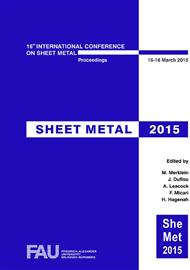p.139
p.147
p.155
p.163
p.173
p.179
p.187
p.195
p.205
Negative Bulge Formation in High Speed Incremental Forming
Abstract:
As a flexible process, Single Point Incremental Forming has the potential to be widely used as a technique for prototyping, discrete or small batch production. However, its notorious lack of accuracy and formability limit a wide adoption on an industrial scale. While the main factor constraining the feasible batch size is the limited processing speed, recent developments towards High Speed SPIF have moved this restricting boundary considerably. Increased strain rates and friction in HS-SPIF introduce their own specific influence on the achievable accuracy. This paper aims to investigate the effect of HS-SPIF on the bulging of the bottom of a work piece. This explicit type of inaccuracy, also known as the pillowing effect, is mainly located in a region of the sheet which is to be left unprocessed, and is therefore challenging to eradicate. Different papers have focused on bulging of a sheet in conventional SPIF, resulting in knowledge about the inwards bending of the sheet at low wall angles. HS-SPIF, however, tends to show a previously unseen outwards bulge at high wall angles due to its unique thermal behavior.
Info:
Periodical:
Pages:
173-178
Citation:
Online since:
March 2015
Authors:
Keywords:
Price:
Сopyright:
© 2015 Trans Tech Publications Ltd. All Rights Reserved
Share:
Citation:


